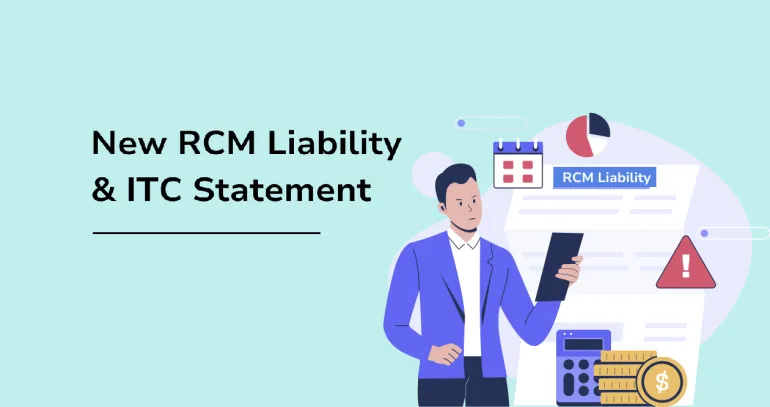New RCM Liability & ITC Statement
To assist taxpayers in correctly reporting Reverse Charge Mechanism (RCM) transactions, a new statement called "RCM Liability/ITC Statement" has been introduced on the GST Portal. This statement will enhance accuracy and transparency for RCM transactions by capturing the RCM liability shown in Table 3.1(d) of GSTR-3B and its corresponding ITC claimed in Table 4A(2) and 4A(3) of GSTR-3B for a return period. Let us review the basics of RCM first to understand the changes
What is the Reverse Charge Mechanism (RCM)?
The Reverse Charge Mechanism is a vital aspect of the GST system. Under normal circumstances, the supplier of goods or services is responsible for paying GST to the government. However, under RCM, this responsibility is shifted to the recipient of the goods or services. RCM is typically applicable in situations where the supplier is unregistered under GST, such as in the case of imports or certain specified goods and services.
For example, if a business imports services from a foreign supplier who is not registered under GST, the Indian business receiving the services is required to pay the GST on behalf of the supplier.
Accurate reporting of RCM transactions is critical because it directly impacts the Input Tax Credit (ITC) that businesses can claim. Any discrepancies in reporting can lead to incorrect ITC claims, potential GST audits, and GST litigation.
Recognizing these challenges, the government has introduced the RCM Liability & ITC Statement to streamline the reporting process and reduce errors.
Overview of the New RCM Liability & ITC Statement
The RCM Liability & ITC Statement is a new feature on the GST Portal designed to assist taxpayers in accurately reporting their RCM transactions. This statement captures the RCM liabilities declared in Table 3.1(d) of GSTR-3B and the corresponding ITC claimed in Table 4A(2) and 4A(3) of GSTR-3B for a particular return period. By doing so, the statement helps ensure that the RCM liabilities and ITC claims are in sync, reducing the risk of discrepancies.
The introduction of this statement is a significant step toward improving the accuracy of RCM reporting. Previously, taxpayers faced challenges in reconciling their RCM liabilities with the ITC claims, often leading to errors that could result in notices from tax authorities. The new statement provides a clear overview of these transactions, making it easier for taxpayers to verify their records and ensure compliance.
Applicability and How to Access the RCM Liability & ITC Statement
The RCM Liability & ITC Statement is applicable to both monthly and quarterly GST filers. For monthly filers, the statement is applicable from the tax period August 2024 onwards, while for quarterly filers, it is applicable from the July-September 2024 period. This means that businesses need to start using the statement for all relevant transactions beginning from these periods.
Accessing the RCM Liability & ITC Statement is straightforward. Taxpayers can navigate to the statement on the GST Portal by following this path: Services >> Ledger >> RCM Liability/ITC Statement. Once accessed, the statement provides a detailed breakdown of the RCM liabilities declared and the ITC claimed, allowing businesses to easily verify the accuracy of their reporting.
Reporting the Opening Balance
One of the critical features of the RCM Liability & ITC Statement is the ability to report the opening balance of RCM ITC. This is particularly important for taxpayers who may have discrepancies in their previous filings. The process of reporting the opening balance is designed to address cases where taxpayers may have paid excess RCM liabilities or claimed excess ITC in previous periods.
Positive Opening Balance: If a taxpayer has paid excess RCM liabilities as declared in Table 3.1(d) of GSTR-3B but has not claimed the corresponding ITC in Table 4A(2) or 4A(3), they need to report a positive value for the excess paid liability as the opening balance in the RCM statement.
Negative Opening Balance: Conversely, if a taxpayer has claimed excess ITC in Table 4A(2) or 4A(3) but has not paid the corresponding RCM liability in Table 3.1(d), they must report a negative value for the excess claimed ITC as the opening balance.
Reclaiming Reversed ITC: In cases where RCM ITC was reversed in previous tax periods through Table 4B(2) of GSTR-3B, eligible taxpayers can reclaim this ITC in Table 4A(5) of GSTR-3B. However, it’s important to note that such reclaimed ITC should not be reported as part of the opening balance.
Taxpayers must ensure that the opening balance is accurately reported by the applicable deadlines. For monthly filers, the opening balance should consider RCM ITC up to the July 2024 return period, while quarterly filers should report the balance considering RCM ITC up to the April-June 2024 return period. The deadline for declaring the opening balance is 31st October 2024, with maximum 3 amendments allowed until 30th November 2024.
The Role of GSTR-3B in the New Statement
A key aspect of the RCM Liability & ITC Statement is its interaction with GSTR-3B, the monthly return that taxpayers file to report their GST liabilities and ITC. The new statement introduces a validation mechanism that cross-checks the RCM liabilities and ITC claims reported in GSTR-3B, helping to prevent discrepancies and excess claims.
The validation works as follows: If the sum of ITC claimed in Table 4A(2) (ITC on import of services) and Table 4A(3) (ITC on inward supplies liable to RCM) exceeds the liability reported in Table 3.1(d) (Tax liability on inward supplies under RCM) plus the closing balance of the RCM ledger, an error message will be generated. This message will prevent the taxpayer from proceeding with their filing until the discrepancy is corrected:
“Input Tax Credit taken in Table 4A(2) and 4A(3) exceeds the liabilities declared in Table 3.1(d) and the closing balance of the RCM liability ledger. Kindly correct the values to proceed further.”
This validation is crucial for ensuring that taxpayers do not inadvertently claim excess ITC, which could lead to compliance issues and potential audits. By introducing this mechanism, the GST Portal helps safeguard against errors in RCM reporting and promotes more accurate filing.
Key Benefits
The introduction of the RCM Liability & ITC Statement represents a significant step forward in ensuring the accuracy of GST filings, particularly concerning RCM transactions. For businesses, this new feature offers several benefits:
Enhanced Accuracy: The statement provides a clear and detailed view of RCM liabilities and corresponding ITC claims, making it easier for businesses to ensure their records are accurate.
Error Prevention: The validation mechanism built into the statement helps prevent excess ITC claims, reducing the risk of errors and the potential for receiving notices from tax authorities.
Streamlined Reconciliation: With the ability to report and amend the opening balance, businesses can reconcile past discrepancies more effectively, ensuring that their GST filings are in order.
Reduced Risk of Litigation: Accurate reporting of RCM transactions minimises the risk of GST litigation, providing businesses with greater peace of mind.
As the RCM Liability & ITC Statement becomes a standard feature on the GST Portal, it is essential for businesses to familiarise themselves with its functionalities and ensure that they are fully compliant. By doing so, businesses can take advantage of the benefits offered by this new statement and avoid potential pitfalls in their GST filings.
Conclusion
The GST landscape continues to evolve, with new features and tools being introduced to enhance compliance and accuracy. The RCM Liability & ITC Statement is one such tool, designed to address the challenges businesses face in reporting RCM transactions. By providing a clear overview of RCM liabilities and ITC claims, and by introducing a robust validation mechanism, this statement helps ensure that businesses can file their GST returns with confidence. As a business owner, it’s important to stay informed about these changes and make the necessary adjustments to your processes to stay compliant and minimize risks.
EaseMyGST is a GST compliance software solution designed to simplify and streamline tax processes for businesses in India. The platform focuses on making GST-related tasks such as e-invoicing, return filing, and data reconciliation easier, more efficient, and accurate. With robust integration capabilities, EaseMyGST connects directly with the GST Network (GSTN), automating many compliance processes to reduce manual intervention and errors.
Key benefits include:
Automation and Efficiency: Automates e-invoicing and return filing, helping businesses maintain compliance with minimal effort.
Data Accuracy: Advanced reconciliation tools minimize mismatches, ensuring accurate GST data.
User-Friendly Interface: Provides a simple and intuitive platform that supports multiple entities and users.
Security and Compliance: Ensures data protection and compliance with government regulations.
EaseMyGST is an ideal solution for businesses looking to enhance their tax compliance while minimizing operational hassles.

